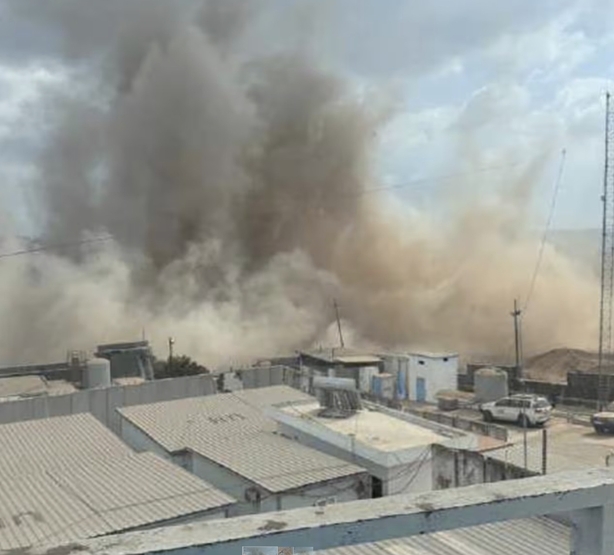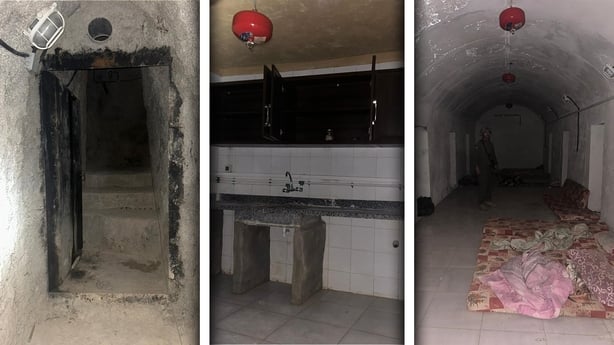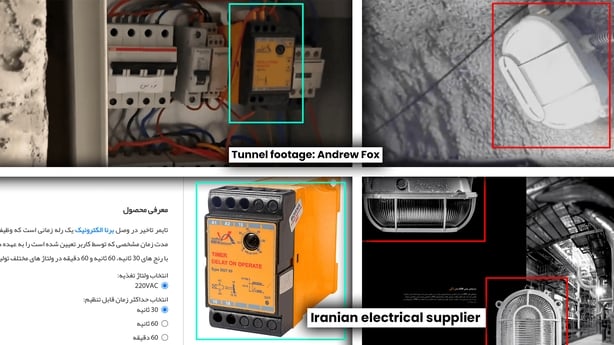The Israeli military has extended civilian evacuation orders to additional towns in the Irish UN peacekeeping zone in Lebanon, including specifically the town of Bint Jbeil. It is the largest town in the Irish UNIFIL area of responsibility, and one of the largest in south Lebanon.
The order was issued yesterday through the Israel Defence Forces' (IDF) Arabic-language spokesperson. Such notices have often preceded significant military operations, artillery attacks, or airstrikes.
It came around the same time Israel's foreign minister, Gideon Saar, said its war against Hezbollah was not yet over, but noted "a certain progress" in diplomatic efforts to achieve a ceasefire.
Separately, new data and satellite imagery shows how almost every building has been destroyed or damaged in Hanine, the closest town on a key route into the Irish UN peacekeepers' main base.
Several other towns and villages within the UNIFIL zone monitored by Irish troops have also been largely flattened, according to recent video footage from Lebanese and Israeli sources, and satellite imagery.
Recent Israeli advances in the Irish UNIFIL Zone
In recent weeks, Israeli troops have been gradually moving north from the de facto border, into Lebanon. Many analysts believe they are trying to create a buffer zone to prevent Hezbollah rockets from reaching populated areas of northern Israel.
Camp Shamrock, the Irish base, is located 7km from the border. Hanine is located 1.5km southwest of the base, on one of several hilltops in the area.
Before and after satellite images taken by Planet Labs, a commercial imagery provider, show little now remains of Hanine.
We need your consent to load this flourish contentWe use flourish to manage extra content that can set cookies on your device and collect data about your activity. Please review their details and accept them to load the content.Manage Preferences
The IDF has previously said that Hezbollah uses woodland areas near Hanine to launch rockets into northern Israel. It is understood Hanine has been hit by extensive artillery fire and at least one air strike in recent months.
To the east of Camp Shamrock, Tayri also shows evidence of significant damage from artillery fire, as does Kounine.
We need your consent to load this flourish contentWe use flourish to manage extra content that can set cookies on your device and collect data about your activity. Please review their details and accept them to load the content.Manage Preferences
Fighting between Hezbollah and the Israeli military has been ongoing across the Irish UNIFIL area since 1 October, when Israeli troops initially crossed into south Lebanon.
UN outpost 6-52 near Maroun El Ras
The IDF units first crossed into Lebanon within the Irish area, near Maroun El Ras. One of two outposts on the border in the area, UNP 6-52, is manned by rotations of platoons of Irish soldiers. It is located on the outskirts of Maroun El Ras.
In the early days of the Israeli incursion, IDF units set up a staging location for tanks and armoured vehicles within metres of the Irish post, prompting outcry from the United Nations, which said it put the Irish peacekeepers in danger.
The IDF troops left the staging post around 7 October. A leaked report from a UN-contributing nation published by the Financial Times said the Israeli post was destroyed with an uncoordinated demolition on that day.

Sources in the Irish Defence Forces indicated the IDF had not moved far, and said fighting in the area remained ongoing.
On Saturday, Hezbollah published what it described as an "aerial reconnaissance" image of a new IDF staging post, located 500m northwest of UNP 6-52. In a statement, Hezbollah said the IDF post was hit "precisely" with multiple explosive drones, and claimed to have caused casualties among the Israeli troops.
While there was visible evidence in video footage of fighting on the ground near Maroun El Ras during the early weeks of the incursion, more recent indications are that Hezbollah has been pushed out of Maroun El Ras, as clashes move north.
It appears Hezbollah fighters are mainly engaging Israeli units through the use of drones and artillery, as IDF troops have gained control over the town.
Read more:
The Irish UNIFIL area: How journalists monitor updates in a war zone
Maroun El Ras is of strategic importance because it is set on a height overlooking Bint Jbeil.
Hezbollah tunnel complex exposed
IDF units have been also clashing with Hezbollah fighters in smaller towns and villages, south, west, and east of Bint Jbeil. It appears the wider strategic aim may be to gain control over the town.
In an indication that they now control Maroun El Ras, the Israeli military brought a small group of journalists and researchers into the town in recent weeks. Among them was a number of Greek and German journalists and Andrew Fox, a military researcher with the Henry Jackson Society, a UK-based think-tank.
The IDF to showed the group a tunnel complex they had uncovered.
Their reporting was embargoed until recent days, but video footage since published by Mr Fox and others shows a Hezbollah tunnel complex almost 1km-long was built into a hill on the north side of the town.
So, after a lot of badgering and making a pain in the arse of myself, I managed to get into Lebanon with the IDF.
— Andrew Fox (@Mr_Andrew_Fox) November 9, 2024
No other Brits present, and I believe this tunnel is now destroyed: so this is an English language exclusive. pic.twitter.com/HLzNSHdZgf
The complex is at the heart of Maroun El Ras, 1.7km from the Irish outpost, which is on the outskirts of the town closer to the border.
The tunnels appear to have been designed to accommodate people and storage, not for fighting or defence. The IDF posted images and footage from inside, showing ammunition and weapons it said were found, as well as sleeping and accommodation areas.

It is unclear when the tunnel complex was constructed, but it had electricity, water, air conditioning and a fire suppression system. One of the end-points centres on a large building, another on an Islamic place of worship and cemetery, another in an open area.
In an effort to verify the users and approximate a date for when the tunnel may have been worked on, Prime Time examined archive satellite imagery and identified electrical fittings from the underground footage.
Satellite images taken in October 2016 and again in May 2017 show a new area covered in chalky rock became visible at one of the end-points of the tunnel in the intervening months.
We need your consent to load this flourish contentWe use flourish to manage extra content that can set cookies on your device and collect data about your activity. Please review their details and accept them to load the content.Manage Preferences
However, engineers who examined the tunnel footage said that it appeared stable, suggesting it may be old. They also said the sprayed concrete walls, electrical installations and related plastic fittings and casings, looked relatively modern. It is unclear when the construction took place, and is possible the tunnel is decades old, and may have been extended or refurbished in more recent years.
Prime Time identified two specific electrical fittings from footage posted by Andrew Fox.
A time delay electrical fitting and the wall lights used to illuminate the tunnels were both found to be manufactured in Iran, and currently only available from Iranian suppliers. Hezbollah is financially backed by Iran, and politically aligned with it.
The earliest published mention of either product online is December 2016.
On Sunday, the IDF said it has now filled the tunnel network with concrete, putting it out of use.

Other tunnel complexes have been destroyed in recent weeks in the Irish UNIFIL area using explosives rather than concrete.
Regular explosive demolitions
To the east of Bint Jbeil, most buildings in Aitaroun have been obliterated. Fierce fighting between Hezbollah and Israeli troops on 26 October in the town resulted in the death of several IDF troops and Hezbollah fighters, according to recent reports from Israeli army radio.
The battle was followed by a series of IDF explosive demolitions.
US academic researchers, Corey Scher and Jamon Van Den Hoek, who analyse satellite imagery from across Lebanon, estimate almost every building in the town has now been destroyed or significantly damaged.
They use computer programming to assess indications of destruction to buildings evident in the images, and calculate damage estimates.
Explosions in Aitaroun in recent weeks. Understood to be footage from an IDF drone. pic.twitter.com/6g6AzzDzBW
— Mark Coughlan (@Mark_Coughlan) November 11, 2024
Elsewhere, on the west side of the Irish area, the town of Yaroun is overlooked by the other Irish-commanded outpost on the de facto border with Israel.
A platoon of Polish troops is based there, under the command of Irish officers in Camp Shamrock. Yaroun has also been all-but destroyed.
Advance into Bint Jbeil
For weeks, Israeli troops have been attacking positions and Hezbollah fighters to the west of Yaroun. They appear to be advancing on Bint Jbeil in a pincer movement.
Prior to the recent Israeli advance, Bint Jbeil had an estimated population of 30,000 people. It has long been considered an Hezbollah stronghold, and was a major centre of resistance during the Israeli occupation of Southern Lebanon between 1982 and 2000.
During the 2006 Israel-Hezbollah war, one of the biggest battles between the two sides took place in the town.
Despite repeated attempts, and an overwhelming manpower advantage, Israeli units never gained control of Bint Jbeil from Hezbollah.
Afterwards, Hezbollah celebrated a major victory, while Bint Jbeil became associated with military and leadership incompetence - and controversy - within the IDF.
In the coming weeks, IDF commanders may look to change that perception.
Any such move would present additional challenges for Irish peacekeepers in Camp Shamrock, during a time where challenges are abundant.
